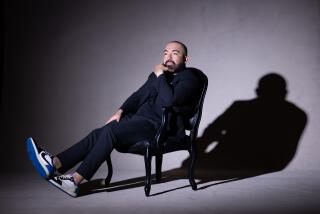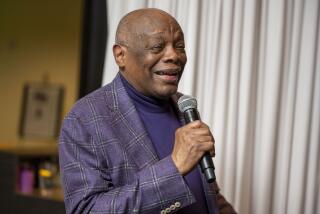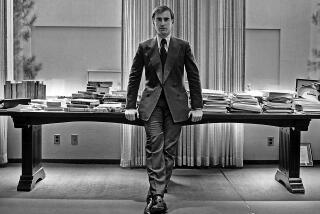Brown Sops Up His Ideas From Odd Stew of Advisers : Campaign: The notions he snatches from his diverse brain trust run from flat taxes to fashion. One aide calls it ‘intellectual liposuction.’
WASHINGTON — One adviser likens the process to “intellectual liposuction.”
When Edmund G. (Jerry) Brown Jr. set out 15 months ago to flesh out themes for his Democratic presidential campaign, he vacuumed up ideas from a diverse set of policy gurus.
“These talks aren’t exactly dialogues: He controls the conversation, and you’re never sure what he’s picking up,” says Arthur Laffer, the supply-side economist who is an informal Brown adviser. “He questions you closely, then it’s--bing--on to another topic.”
As he did while governor of California, from 1975 to 1983, Brown grabs ideas from people the way an old mail train, careening at full throttle, would scoop up a mail pouch from a railroad siding.
His inner circle of advisers, who also confer on political tactics, includes Jodie Evans, his campaign manager; Patrick Caddell, the pollster and former aide to President Jimmy Carter who specializes in “outsider” politics; and Jacques Barzaghi, the self-described former French sailor who is Brown’s best friend, wardrobe adviser and campaign clock-watcher.
But there are others--including two conservative proponents of the flat tax whose brains Brown apparently picked by reading their 1981 book. Brown credits Alvin Rabushka and Robert E. Hall for his idea to jettison the entire federal tax system--including income, estate, corporate and Social Security taxes--and replace it with a 13% tax on all personal income, plus a 13% value-added tax on all manufactured goods. Only three deductions would be permitted in the flat tax: home mortgage interest, rent and charitable contributions.
Rabushka and Hall, senior fellows at Stanford University’s conservative Hoover Institution, have never talked to Brown--although, at the campaign’s request, Rabushka recently began fielding press inquiries about the tax proposals.
Rabushka says he’s ready to talk to Brown “whenever he wants” and is prepared to vote for him over President Bush. He’s still in the dark, however, on what drew Brown’s attention to the flat tax.
“It beats me,” Rabushka says. “Maybe Mother Teresa said, ‘Jerry, the flat tax is the way to go.’ ”
As for Brown’s criticisms of the corruptive influence of money on politics, credit Richard N. Goodwin, at least in part. Goodwin, a former speech writer for Presidents John F. Kennedy and Lyndon B. Johnson, is a longtime friend of Brown’s. Goodwin has discussed the issue with him and used the theme in his latest book, “Promises to Keep.” Brown, Goodwin says, used portions of the book in his campaign announcement last October.
Another economic adviser is Jude Wanniski, a supply-side theorist and former Wall Street Journal editorial writer who was close to the Ronald Reagan Administration. Wanniski says he has had “dozens” of conversations with Brown, including chats about the flat tax and Wanniski’s idea of eliminating capital gains taxes.
But Wanniski said he was surprised when Brown announced his support for the flat tax in New Hampshire last January. “I thought it was too far out, even for Brown,” said Wanniski, who is president of a consulting firm called Polyconomics Inc. in Morristown, N.J.
And Laffer, an economics consultant in La Jolla, says he’s been talking to Brown intermittently since June, 1978, when the then-governor became a born-again tax-cut advocate amid the political turbulence of California’s Proposition 13 property-tax revolt.
Since then, Laffer says he talked to Brown about a number of fiscal ideas the governor supports: amnesty for federal tax evaders; tax-advantaged “enterprise zones” to help redevelop cities, and the phased reduction in benefits for welfare recipients who get jobs, to encourage the poor to work.
(Brown has credited Jack Kemp, the secretary of housing and urban development, with introducing him to the enterprise-zone idea.)
“Jerry has always been a fiscal conservative,” says Laffer, who is an original advocate of the supply-side theory, which states that sharp tax cuts would spur national productivity enough to more than make up for the initial loss in tax revenue. Reagan cited Laffer’s theories for his income-tax reductions in the mid-1980s.
Caddell’s scope is broader--in fact, both he and the candidate say he gets too much credit for Brown’s ideas. The Clinton camp has suggested that he is a Svengali directing the campaign from his home on the west side of Los Angeles. There were even press reports, emanating from Clinton aides, that the whole premise of Brown’s campaign came from a Caddell movie script.
Caddell calls such reports nonsense, but acknowledges that he talks to Brown every day or two about “themes and thematics,” and that he was among the group that Brown consulted in early 1991 when Brown was considering a run for the Senate or the presidency.
Barzaghi, too, advises on a range of issues. A striking sight at Brown’s appearances in his signature beret and all-black outfits, Barzaghi is now chiefly in charge of making sure the candidate doesn’t get too long-winded at campaign stops. But he was among Brown’s first policy advisers and his advice remains essential, Caddell says.
“He and Jerry have a 25-year, very, very personal relationship, and I’m sure they talk about every subject,” Caddell says.
Brown has also stressed his ties to consumer advocate Ralph Nader, saying he’d invite him to join the Cabinet. But Nader says his relationship with this candidate is non-exclusive. “I’m willing to advise any candidate who’s willing to listen,” he says.
More to Read
Get the L.A. Times Politics newsletter
Deeply reported insights into legislation, politics and policy from Sacramento, Washington and beyond. In your inbox three times per week.
You may occasionally receive promotional content from the Los Angeles Times.











